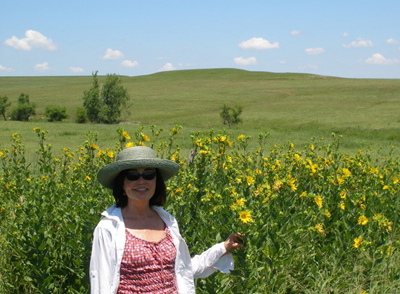Human Flower Project
Tuesday, October 09, 2007
No Direction Home: Compass Plant
With a navigational sunflower for a guide, Jill Nokes takes us wading into the Kansas prairie. Eyes out for Jill’s forthcoming book Yard Art and Handmade Places, due from University of Texas Press next month.
 Compass plant
Compass plant
Silphium lacinatum
Photo: Jill Nokes
By Jill Nokes
What a thousand acres of compass plant looked like when they tickled the bellies of the buffalo is a question never again to be answered, and perhaps not even asked.
Aldo Leopold, A Sand Country Almanac
The Flint Hills of Kansas must be beautiful this time of year, when all the grasses reach their full height and glory. When we visited the Tallgrass Prairie National Preserve near Strong City, Kansas, in July, abundant summer rains had hastened the growth and lushness of the grasses. Even that patriarch of the prairie, big bluestem (Andropogon gerardii), was beginning to bloom then. Yet most vivid to me in that endless ocean of grass were the isolated stands of compass plant (Silphium lacinatum).
This slow-growing, long-lived, eye-catching member of the sunflower family can grow as tall as twelve feet, with roots as long or longer burrowing deep into the earth. The species name lacinatum means torn, or jagged, and refers to the deeply cut, sandpapery leaves. These leaves are held on the long stiff stems on a north-south axis; broadside to the sun morning and evening, but on edge at midday. This clever adaptation maximizes photosynthesis while minimizing evaporation during hot summer days. Compass plant’s regular alignment with the cardinal points served as living guideposts to lost travelers who found themselves cast upon a landscape that seemed featureless and endless.
In his book PrairyErth (A Deep Map): An Epic History of the Tallgrass Prairie Country, William Least Heat Moon tells us, “Where these yellow rays of blossoms once grew in abundance ten feet high, some prairie tribes refused to camp, believing that the plants drew down lightning, yet during electrical storms the people burned the dried root to ward off thunderbolts.”
Besides meteorological and directional powers, compass plant offered the original prairie peoples an astounding number of medicinal uses. Extractions were made to treat rheumatism, scrofula, constipation, and from this same plant also came a diuretic, a diaphoretic, an expectorant, an anti-spasmodic, a vermifuge for their ponies, as well as a general tonic for listlessness. We don’t often regard medicinal plants as being pleasant-tasting, but many sources report that children would break open the stems and chew the hardened balsamic sap like gum.

Jill Nokes and a stand of Silphium lacinatum, August 2007
Tallgrass Prairie National Preserve near Strong City, Kansas
Photo: Courtesy of Jill Nokes
According to Moon, its name in several dialects translates as “big medicine.” Today, these protected remnant patches of virgin tallgrass prairies amount to only a tiny fraction of the original stands. Grasslands are often difficult for people of European descent to interpret, understand, and value. Listing the reported uses and meaning of just one single plant from the diverse mosaic of the tallgrass prairie, we are reminded of all the knowledge and wisdom that was lost when the prairies were plowed and grazed out of existence. Perhaps the compass plant can help guide us back to a place of humble understanding.




